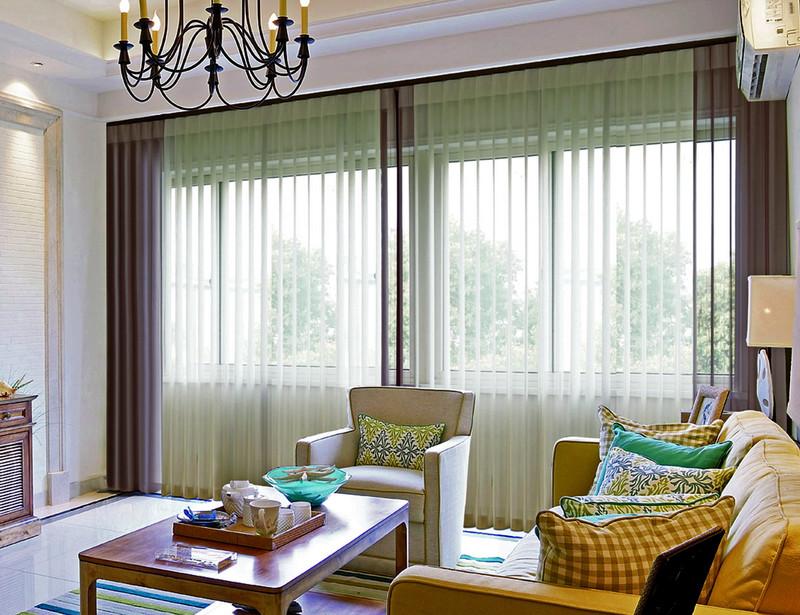Fabric vertical blinds are a popular choice for window treatments, offering a unique blend of style, versatility, and function. Homeowners often choose fabric blinds for their ability to complement decor while controlling light and privacy. However, one common question is: Can you see through fabric vertical blinds? The answer depends on factors like the type of fabric, lighting conditions, and how much privacy you need.
For a comprehensive guide on selecting fabric blinds that suit sliding doors specifically, you might want to check out this resource on fabric blinds for sliding doors.
Transparency and Opacity of Fabric Vertical Blinds
Factors That Affect See-Through Ability
The level of transparency in fabric vertical blinds can vary significantly depending on the type of fabric, its thickness, and the weave. Generally, these blinds fall into three categories of opacity: sheer, semi-sheer, and blackout. Here’s a closer look:
- Sheer Fabric Blinds: Sheer fabrics allow the most light to pass through, making them semi-transparent. During the day, you can see through them, though the view may be slightly distorted. However, at night, when indoor lights are on, these blinds can become more transparent from the outside, reducing privacy.
- Semi-Sheer Fabric Blinds: Semi-sheer blinds are thicker than sheer options but still let in some natural light. They provide a bit more privacy during the day but may still allow visibility at night if there’s interior lighting. These blinds are suitable for rooms where you want some light filtering without total opacity.
- Blackout Fabric Blinds: Blackout fabric vertical blinds use dense, opaque fabric to block light completely. They offer maximum privacy and block visibility in both directions, making them ideal for bedrooms, bathrooms, and other private spaces.
Daylight vs. Nighttime Visibility
Light conditions play a major role in how visible a room is through fabric blinds. In bright daylight, even sheer fabric vertical blinds may provide adequate privacy since sunlight limits the amount you can see inside. At night, when interior lights are on, the fabric can become more translucent, allowing people outside to see in more easily.
This effect, known as silhouette visibility, means that while fabric vertical blinds can reduce visibility, they do not offer complete privacy in all lighting conditions. If you’re concerned about privacy at night, opting for darker or blackout fabric is more effective.
Choosing the Right Fabric for Privacy
Different Fabrics and Weaves
Fabric vertical blinds come in a range of materials, each with unique properties. Polyester is one of the most common options, offering durability and a variety of opacity levels. Cotton blends and synthetic materials are also available, each providing different textures and levels of see-through capability.
Benefits of Polyester and Synthetic Fabrics
Polyester and synthetic materials, particularly those with tight weaves, tend to be less transparent. They’re often used for blackout blinds due to their ability to block light effectively. Polyester blinds are also less likely to fade, maintaining their opacity over time.
Natural Fabrics for Light Diffusion
For softer light and moderate privacy, natural fabrics like cotton and linen are popular. They offer a more organic feel, diffusing light gently but are generally less opaque. If you want both style and a bit of privacy, these materials work well in living rooms or dining areas where total blackout isn’t necessary.
Privacy Tips for Fabric Vertical Blinds
Layering with Additional Treatments
One effective way to improve privacy with fabric vertical blinds is by layering them with other window treatments, such as sheer curtains or roller shades. By combining blinds and shades, you can increase privacy without sacrificing natural light.
Motorized Options and Adjustability
Motorized fabric vertical blinds provide additional control over light and privacy. With a motorized system, you can adjust the angle of the slats or open them entirely with ease. This flexibility lets you quickly respond to changing light conditions or the need for privacy.
Choosing Colors and Patterns for Privacy
Darker-colored fabrics and certain patterns can enhance privacy. Darker shades are less transparent, reducing visibility from outside. Patterns, especially busy or textured ones, can also obscure visibility by creating visual barriers.
Benefits of Fabric Vertical Blinds
While privacy is essential, fabric vertical blinds offer several other advantages:
- Versatility in Light Control: Fabric blinds allow for fine-tuned control of light, making them suitable for living rooms, bedrooms, and offices.
- Aesthetic Appeal: Fabric vertical blinds are available in a wide range of colors and designs, so they can complement nearly any interior style. Unlike vinyl blinds, fabric options bring warmth and texture to a room.
- Sound Insulation: Thicker fabric vertical blinds can help reduce noise, making them a good choice for rooms near busy streets or noisy areas.
- Energy Efficiency: Fabric blinds can provide some insulation, helping to regulate temperature. Blackout fabric vertical blinds are particularly effective at blocking heat in summer and retaining warmth in winter.
Conclusion
Fabric vertical blinds are a stylish and functional choice for window coverings, providing options that range from sheer to blackout depending on your needs. When choosing fabric blinds, consider both the fabric’s opacity and the lighting conditions in your space. For maximum privacy, especially at night, blackout fabrics or additional layering with shades can prevent see-through issues.

